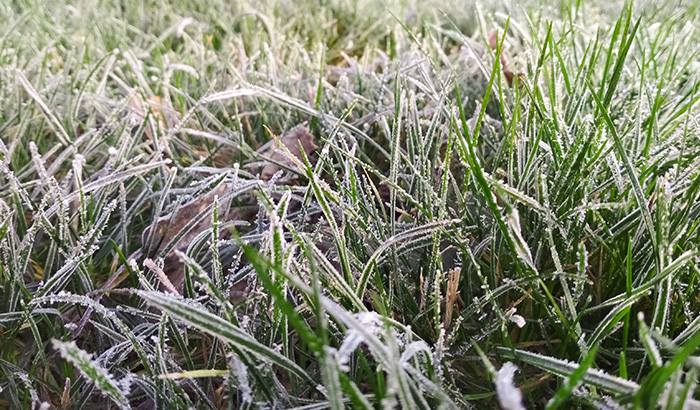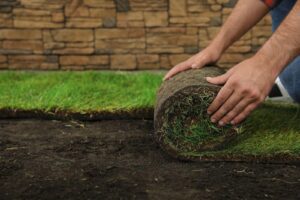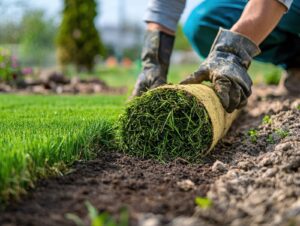As winter approaches, homeowners and landscapers alike face a common concern: the survival of their newly laid sod through the cold months. The question, “Can new sod survive the winter?” is not just a query but a crucial aspect of lawn care.
Winter brings with it a unique set of challenges for any lawn, especially for new sod still in its delicate establishment phase. The key to ensuring the health and beauty of your lawn through winter lies in effective winter sod care. This involves good timing, appropriate watering practices, and protective measures against the harsh winter elements.
Understanding the nuances of winter sod care is essential for maintaining the aesthetic appeal of your landscape and safeguarding your investment in your lawn. In this blog, we’ll delve into the five critical considerations to keep in mind to ensure your new sod thrives during the winter months.
Whether you’re a seasoned landscaper or a homeowner new to lawn care, these insights will help you navigate the winter season with confidence, ensuring your sod remains lush and vibrant.
The Right Time to Plant New Sod Before Winter
Timing is everything when it comes to ensuring the survival and health of new sod through the winter months. The ideal time to plant new sod is a crucial factor that significantly influences its ability to withstand the cold temperatures of winter. However, it is possible to plant sod in the winter.
For those of us in Utah, the best time to lay new sod is typically in the early fall. This period offers a sweet spot where the soil is still warm from the summer sun, encouraging root growth without intense heat that can stress new grass.
Planting new sod during this time allows it to establish a robust root system before the winter freeze sets in. A well-established root system is critical for new sod to absorb the necessary water and nutrients, making it resilient enough to survive and thrive during the cold season.
If new sod is laid too close to winter, it might not have enough time to establish a robust root system. Without deep, strong roots, the sod is more vulnerable to winter kill, where cold temperatures and frost can damage or even kill the grass.
On the other hand, laying sod too early in the summer also poses risks, as the intense heat and potential drought conditions are less than ideal.
Moreover, the moderate temperatures of early fall also provide a comfortable environment for the sod to develop a healthy green top. A healthy green top is essential for photosynthesis and overall plant health. And healthy plants better withstand harsh winter conditions.
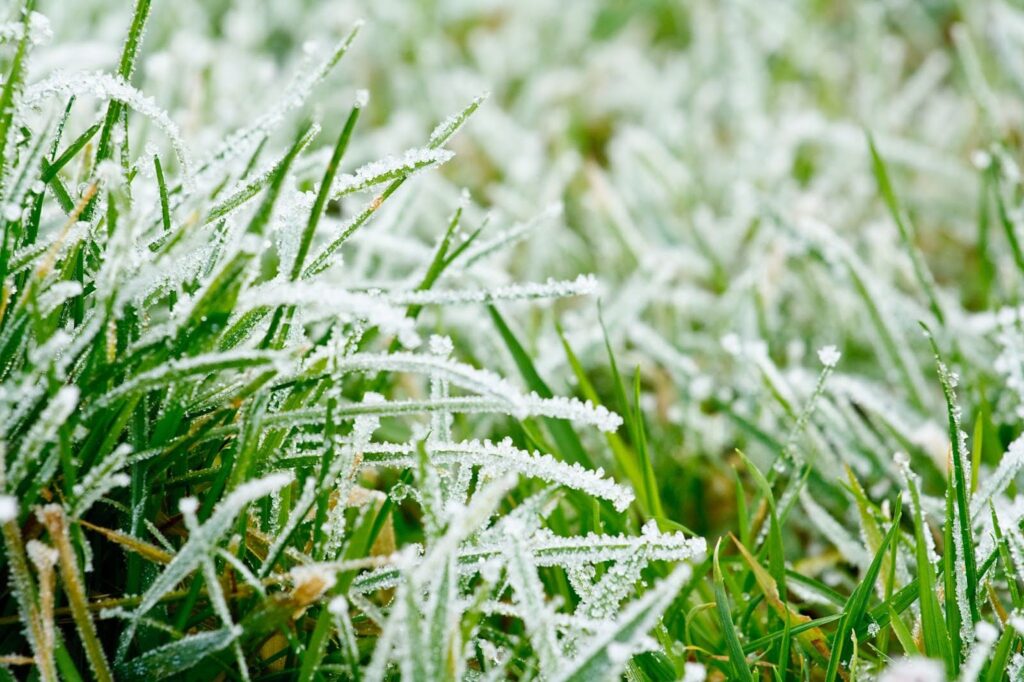
Winter Watering and Moisture Management
Navigating the winter months with new sod requires a keen understanding of moisture management. While it’s easy to assume that the cooler temperatures negate the need for regular watering, this isn’t entirely true. Proper winter sod care involves a balanced approach to watering, ensuring your new sod remains healthy and resilient against the cold.
Keep in mind that even during winter, new sod needs moisture. The key is maintaining a balance between too much and too little hydration.
Overwatering may lead to ice formation on the sod, which could suffocate and damage the grass. Conversely, under-watering can cause the roots to dry out, which weakens the sod’s ability to withstand cold temperatures.
Here are some practical tips for winter watering and moisture management:
Monitor soil moisture: Regularly check soil moisture levels. The soil should be damp to the touch but not saturated. If the soil feels dry, it’s time to water it.
Water during warmer days: Choose a warm, sunny day for watering. Doing this encourages quick absorption and reduces the risk of freezing.
Water in the morning: Watering in the morning allows the sod to absorb moisture before the temperatures drop in the evening.
Avoid waterlogging: Be cautious not to overwater. Excess water can freeze and create a layer of ice, harming the sod.
Reduce watering frequency: During winter, the sod’s water requirements are lower than in warmer months. Adjust your watering schedule accordingly, focusing on maintaining just enough moisture.
Protect against frost: Avoid watering if frost is on the forecast. Wet sod is more susceptible to frost damage than dry sod.
You can use these guidelines to effectively manage the moisture levels of your new sod during winter, ensuring it remains healthy and well-prepared to burst into lush greenery come spring. Remember, a little attention to winter sod care goes a long way in preserving the beauty and health of your lawn.
Protecting New Sod from Winter Elements
Winter in Utah can be intense. For your new sod, it’s a season of vulnerability. Protecting your new sod from harsh winter elements like frost and snow is crucial to ensure it emerges lush and green in spring. Here are some practical steps to shield your new sod and minimize damage from the cold weather.
1. Limit foot traffic
One of the simplest yet most effective ways to protect new sod during winter is to minimize foot traffic. Walking on frost-covered sod can break the grass blades and damage the roots, impeding its growth. Keep foot traffic to a minimum to allow your sod to remain undisturbed and healthy.
2. Use protective covers
In areas with severe winter conditions, consider using burlap or frost blankets to cover the new sod. These covers provide a layer of insulation, protecting the sod from extreme cold and frost. Just make sure to remove these covers on warmer days to allow the grass to breathe.
3. Avoid de-icing salts
Be cautious about using salts if you need to de-ice nearby walkways or driveways. De-icing salts can be harmful to new sod and cause dehydration and chemical burns. Opt for sand or other non-salt de-icers near your sodded areas.
4. Gentle snow removal
When removing snow, do it gently and avoid piling it onto your new sod. Heavy snow piles can compact the soil and suffocate the grass. Use a plastic shovel or a broom to gently remove snow without damaging the sod.
5. Monitor for disease and pests
Winter conditions sometimes foster fungal infections or attract pests. Keep an eye on your sod for any signs of disease or pest activity and address them promptly.
By taking these steps, you can effectively protect your new sod from the harsh winter elements. Remember, a little extra care during these colder months makes a significant difference in the health and appearance of your lawn come spring.
Ongoing Maintenance and Monitoring
Your lawn is an investment, and like any investment, it requires ongoing maintenance and monitoring, especially during the winter months. Regular care of your new sod during winter is about preservation and ensuring its future health and vibrancy. Regular maintenance and monitoring are key to a healthy, lush lawn.
Here are some ways to help you keep track of your sod’s health and ensure it receives the care it needs to thrive.
Check for color changes
Keep an eye on the color of your sod. While it’s normal for grass to become somewhat dormant and less vibrant in winter, watch out for any unusual yellowing or browning, which could indicate dehydration or disease.
Monitor soil moisture
Regularly check the soil’s moisture level. The soil should be moist but not soggy. If the ground is frozen, it’s a sign that the sod is not getting the water it needs.
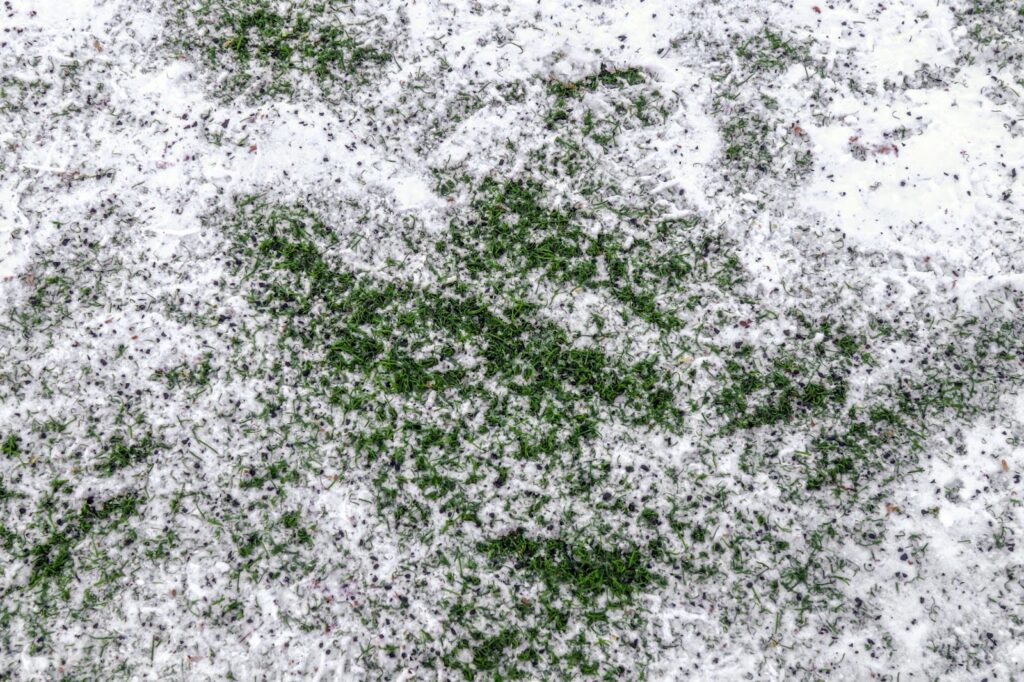
Look for Signs of Frost Damage
After a frost, check your sod for signs of damage, such as blackened or mushy grass. This usually indicates that the cold weather has affected the sod.
Inspect for pest activity
Even in winter, pests can be a problem. Look for signs of insect activity or damage, such as chewed grass blades or bare patches.
Assess root health
If possible, gently lift a corner of the sod to check the roots. Healthy roots should be firm and white or cream-colored. If they’re brown and mushy, it’s a sign of root rot.
Watch for weed growth
Keep an eye out for weeds, which can compete with your new sod for nutrients and water. Remove weeds promptly to give your sod the best chance of thriving.
Carpet Your Lawn with Monarch Sod
The key to successful winter sod care lies in understanding and addressing the unique needs of new sod. By ensuring proper installation timing, balanced moisture levels, and minimizing physical stress, your new sod will thrive through the winter months.
If you have any questions or need expert advice on winter sod care, Monarch Sod is here to help. Visit our website or give us a call for personalized assistance and high-quality sod solutions. We’re committed to helping you achieve the perfect lawn, regardless of the season.
Contact Monarch Sod for all your lawn needs, and let us be your partner in creating a beautiful, enduring landscape. Your beautiful lawn is our pride.
situs hk toto slot toto slot link slot gacor situs slot gacor situs toto toto slot toto togel toto slot situs toto situs togel bento4d login toto slot situs gacor








